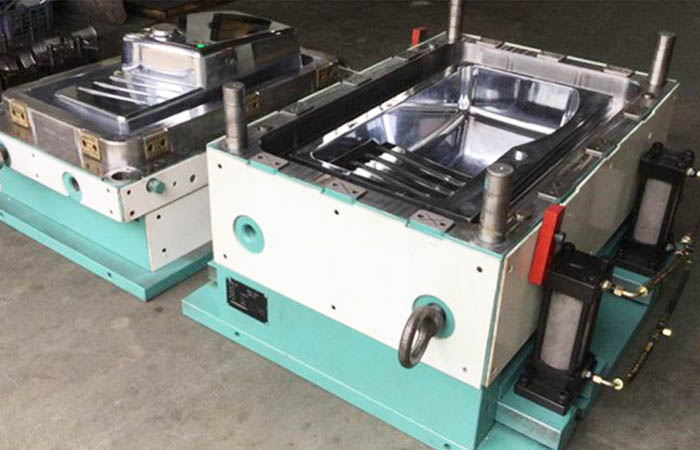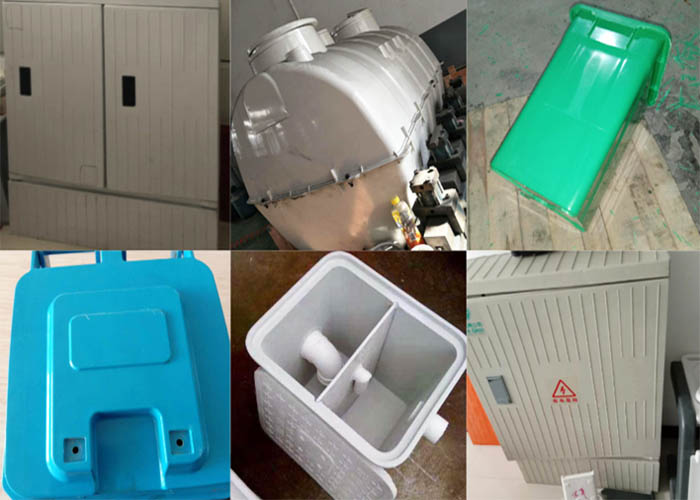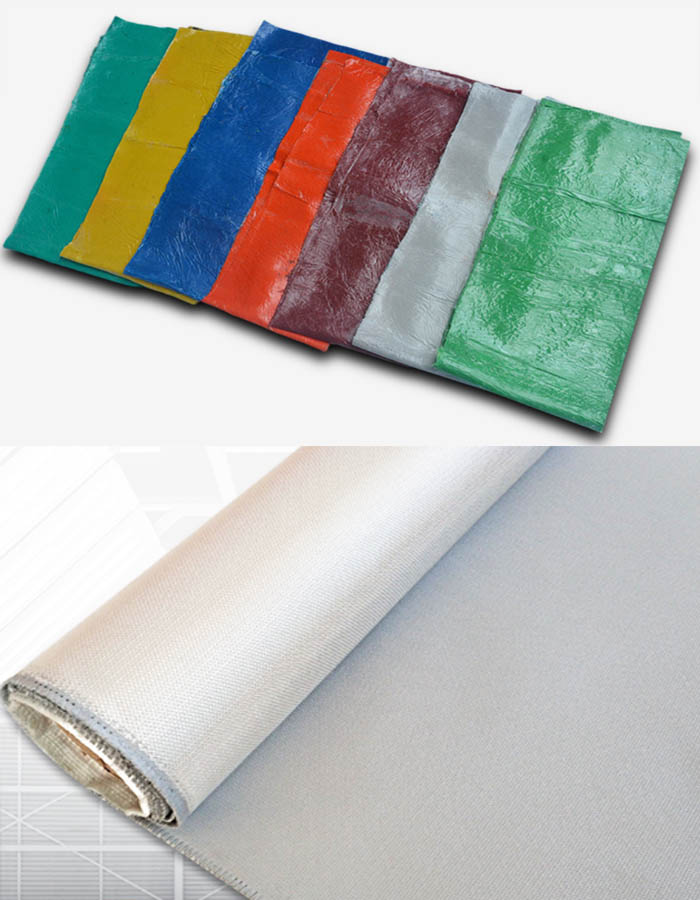SMC Compression Mold
Create exquisite SMC Compression molds and innovative solutions to help you achieve excellent production and meet your custom needs with superior performance and reliable delivery

What is SMC(Sheet Molding Compound) Compression Mold
SMC (Sheet Molding Compound) compression mold, also known as an SMC compression molding tool, is a specialized mold used in the manufacturing process of components made from Sheet Molding Compound (SMC),it is compression molding process. SMC is a type of composite material used in various industries, such as automotive and aerospace, for the production of lightweight, high-strength, and corrosion-resistant parts.
SMC is composed of several key ingredients, including thermosetting resins, chopped glass fibers, fillers, and additives. The SMC material is typically supplied in the form of sheets or bulk compound. The SMC compression molding process involves placing the SMC material into a mold cavity, and then a combination of heat and pressure is applied to shape and cure the material. The SMC mold plays a crucial role in this process by defining the final shape, texture, and surface finish of the part being produced.
Our company specializes in manufacturing high-quality SMC molds and provides customers with customized solutions. We have advanced manufacturing equipment and technical teams that are able to design and manufacture excellent mold products according to customer needs. We focus on quality control to ensure each mold has excellent performance and reliable delivery. Whether it is small batch or high-volume production, we can meet the needs of our customers. If you have any needs about SMC molds or want to know more information, please feel free to contact us.
What is SMC Compression Mold Forming Process
SMC (Sheet Molding Compound) mold is a special mold used to manufacture composite parts. SMC molds are formed using compression molding. Compression molding is a thermosetting material molding process in which the material is compressed into the desired shape by combining high pressure and high temperature.
The following is the process of SMC mold forming:
- Material Loading: SMC materials are usually supplied in sheet or bulk form and are placed into the open cavity of the mold.
- Mold Close: A mold usually consists of two halves or beats that come together to seal the SMC material.
- Compression: High pressure is applied to the closed mold, compressing the SMC material and forcing it to conform to the shape of the mold.
- Heating: The closed mold is heated to a specific temperature, which activates the thermoset resin, causing it to solidify and harden.
- Cooling: After solidification, the mold is cooled to further harden the material.
- Mold Opening: Once the part is fully cured and solidified, the mold is opened and the completed part is removed.
This process allows SMC material to maintain the desired shape and size after curing with heat. Compression molding is suitable for many composite materials.SMC mold is a key tool used in this compression molding process to shape and customize the final product.




SMC molds are critical for shaping SMC materials into complex, high-performance parts. They are crucial to achieve the mechanical properties, surface quality and dimensional accuracy required for SMC components. These molds vary in complexity and can range from simple shapes to complex and detailed designs, depending on the requirements of the final product.


Main features of SMC Compression Mold
Custom Design: SMC molds are custom designed to match the shape, size and details of a specific part.
High Temperature and Pressure Tolerance: These molds are made to withstand the high heat and pressure required during the manufacturing process.
Surface Finish: The surface smoothness of the mold can affect the texture and appearance of the final SMC part.
SMC molds are critical for shaping SMC materials into complex, high-performance parts. They are crucial to achieve the mechanical properties, surface quality and dimensional accuracy required for SMC components. These molds vary in complexity and can range from simple shapes to complex and detailed designs, depending on the requirements of the final product.
How to solve the deformation during SMC mold production process
During the processing of SMC molds, uneven curing of the molding material and shrinkage of the product after demoulding may occur. How to deal with this?
During the resin curing reaction, the chemical structure changes, causing volume shrinkage. The uniformity of curing makes the product tend to warp toward the side that solidifies first. Secondly, the thermal expansion coefficient of the product is larger than that of the steel mold. When the SMC mold is cooled, its unidirectional shrinkage rate is greater than the unidirectional thermal shrinkage rate of the mold. For this reason, the following methods are used to solve it:
1. Reduce the temperature difference between the upper and lower molds and make the temperature distribution as uniform as possible.
2. Use cooling fixtures to limit deformation.
3. Increase the molding pressure appropriately to increase the structural compactness of the product and reduce the shrinkage of the product.
4. Increase the heat preservation time appropriately to reduce internal stress.
5. Adjust the curing shrinkage of the SMC mold.






What is the difference between SMC material and fiberglass?
SMC material (Sheet molding compoun), Chinese is sheet molding compound. The main raw materials are composed of SMC special yarn, unsaturated resin polyester, low shrinkage additives, fillers and various additives. It is a kind of resin-based composite material. In the late 1980s, my country introduced advanced foreign SMC material production lines and production processes. SMC materials have excellent electrical properties, corrosion resistance, light weight, easy and flexible engineering design, and their mechanical properties are comparable to some metal materials. Therefore, they are widely used in transportation vehicles, construction, electronics/electrical and other industries. SMC material is a type of fiberglass, and fiberglass covers a much wider range than SMC materials.
Fiberglass is glass fiber reinforced plastic. It is a composite material that uses glass fiber and its products (fiberglass cloth, tape, felt, yarn, etc.) as reinforcing materials and synthetic resin as the matrix material. The concept of composite materials means that one material cannot meet the requirements of use, and two or more materials need to be combined together to form another material that can meet people’s requirements, that is, composite materials. Although a single type of glass fiber has high strength, the fibers are loose and can only bear tensile force, but cannot bear bending, shearing and compressive stress. It is not easy to make a fixed geometric shape and is a soft body. Because its strength is equivalent to steel, it also contains glass components, and it also has the color, shape, corrosion resistance, electrical insulation, heat insulation and other properties of glass. Like glass, the easy-to-understand name “glass fiber reinforced plastics” is formed. It can be seen that the meaning of fiberglass refers to reinforced plastics with glass fiber as reinforcing material and synthetic resin as binder. It is called glass fiber reinforced plastic abroad.
Features of SMC products produced by SMC Compression molds
SMC (Sheet Molding Compound) molds have many significant features and advantages, making them ideal for manufacturing high-performance parts. Here are some of the key features and benefits:
1. Lightweight
SMC molds can manufacture lightweight parts, which is crucial for applications in fields such as automotive and aerospace, as it helps reduce overall weight and improve fuel efficiency and flight performance.
2. High Strength
SMC material itself has high strength and stiffness, which allows parts made from SMC molds to withstand important mechanical stress.
3. Corrosion Resistance
Parts produced by SMC molds have excellent corrosion resistance, making them suitable for harsh environments and applications exposed to chemicals.
4. Complex Geometries
SMC molds can manufacture parts with complex geometries, which makes them suitable for applications that require special design.
5. High Production Efficiency
SMC molds use compression molding technology, which has high production efficiency and can produce parts in large quantities.
6. Excellent Surface Finish
SMC molds can manufacture parts with excellent surface quality, which is very important for applications where appearance is important.
7. Good Insulation Properties
Parts made from SMC molds usually have good electrical insulation properties and are suitable for electrical and electronic applications.
8. Customization
SMC molds can be customized according to specific customer needs, including shape, size and surface texture.
9. Quality Consistency
Due to the adoption of precise mold design and control processes, SMC molds can achieve a high degree of quality consistency, reducing part changes and the rate of defective products.
10. Environmentally Friendly
SMC materials and mold manufacturing processes are generally environmentally friendly because they reduce waste and energy consumption.
Taken together, SMC molds have huge advantages in producing high-performance, lightweight, corrosion-resistant and complex-geometry components, suitable for various application fields. These advantages make it a preferred choice in many industries, including automotive, aerospace, construction and power.